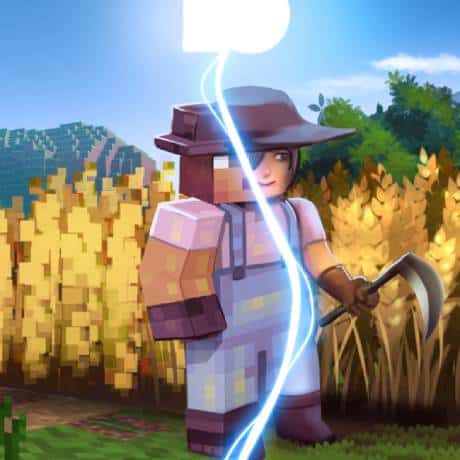Sustainability: Eating Insects to Save the Earth
Author:
 | Lionel Thomas Father, Gamer and Founder with a Passion for Health, AI, Environment and Gamification of Life. |
Author Tools:
- Grammarly (Spelling and Grammar)
- Fliki (Audio by AI)
- Other Tools (AI)...
Artists:
- Roy Wibowo (Header)
- Lionel Thomas using DALL-E 2 [AI Generated] (Content)
References:
1. Insects for food and feed
Food and Agriculture Organization of the United Nations
https://www.fao.org/edible-insects/en/
Summary:
Predictions towards 2050 suggest a population increase to 9 billion people, leading to increased food demand and putting a strain on the environment due to scarcity of agricultural land, water, forest, fishery, biodiversity resources, and non-renewable energy.
Insects, being high in quality protein, vitamins, and amino acids, can offer a solution. They have a high food conversion rate, requiring significantly less feed than conventional livestock to produce the same amount of protein. Insects also produce fewer greenhouse gases and ammonia than traditional livestock, and they can be reared on organic waste, making them a potentially more sustainable source of protein. They could be used directly for human consumption or indirectly in recomposed foods and as a protein source in animal feed.
Since 2003, the Food and Agriculture Organization (FAO) has been researching edible insects and their role in food security in various countries worldwide. Their work includes knowledge generation and sharing, raising awareness about the role of insects, providing support to member countries through projects, and fostering networking and multidisciplinary interactions with various sectors.2. How many people on our planet eat insects: 2 billion?
Research Gate
https://www.researchgate.net/publication...
Summary:
The article from the Journal of Insects as Food and Feed critically evaluates the widely cited figure that approximately two billion people on Earth consume insects. The original number is sourced from a FAO report from 2013, but the authors aim to investigate its accuracy, given the fact that there are no global statistics on insect consumption. Key factors influencing insect consumption include cultural acceptance, availability and seasonality of edible insects, and shifts in dietary habits due to socio-economic development. The authors highlight the lack of data at national or sub-national levels which could offer a more precise picture of insect consumption. Therefore, they conclude that determining an accurate number of insect consumers globally is extremely difficult, and the popularly cited figure of two billion might be an overestimation.3. Fighting Peak Phosphorus
The Future of Strategic Natural Resources
http://web.mit.edu/12.000/www/m2016/fina...
Summary:
This document outlines the alarming rate at which the world's phosphorus reserves are being depleted, due to their use in global food supply chains, particularly as crop fertilizers. With current rates of consumption, known phosphorus reserves could be exhausted within 80 years.
To address this issue, the document presents a three-part plan proposed by Mission 2016. Firstly, the plan suggests reducing demand through smarter fertilizer use. This involves a worldwide campaign focusing on developing countries that have high consumption rates, to educate and equip farmers with tools to accurately assess their fertilizer needs and avoid overuse.
Secondly, it proposes recycling phosphorus from human and animal waste. Innovative techniques such as struvite formation and thermochemical treatments are recommended, with examples of successful implementations in the EU, Canada, and the US. The plan advocates for these methods to be introduced in rapidly developing regions, such as China and India, which could significantly reduce their phosphorus waste and curtail the growing demand for phosphorus imports.
Lastly, the plan encourages the exploration of new potential mining zones to extend the lifespan of known phosphorus reserves. This multi-pronged approach could prevent a looming phosphorus shortage if action is taken immediately.
The document also discusses the historical context, tracing back to the agricultural practices in the US and USSR during the Green Revolution in the 1970s and 80s, which led to a significant increase in phosphorus production. It also notes the shift in the largest phosphorus consumers from the US to India and China.
To successfully manage phosphorus resources, the document recommends global cooperation and knowledge sharing through platforms such as the Open Information Exchange and the UN's Strategic Minerals Association. The ultimate aim is to create sustainable agricultural practices worldwide that prevent phosphorus depletion and environmental damage.4. Short-term policy considerations to respond to Russia-Ukraine crisis disruptions in fertilizer availability and affordability
International Food Policy Research Institute
https://www.ifpri.org/blog/short-term-po...
Summary:
This blog post by Charlotte Hebebrand and David Laborde on the International Food Policy Research Institute (IFPRI) site discusses the impact of the Russia-Ukraine conflict on fertilizer availability and affordability and suggests short-term policy responses to mitigate the negative effects on global food security.
Key points include:
Maintain global trade to ensure fertilizer availability: Governments should remove existing export restrictions, forgo new ones, and designate fertilizers as essential goods. The impact of economic sanctions on Russia and Belarus, significant fertilizer producers, needs monitoring. They suggest mitigating potential sanction impacts via financial and technical solutions, using "comfort letters", legal helpdesks, and special credit lines. They also propose barter trade as a short-term solution for governments to secure fertilizer supplies.
Help all farmers increase their fertilizer use efficiency: With constrained supply, the priority should be to educate farmers to improve fertilizer use efficiency. This could be achieved via extension services providing knowledge and tools for more efficient, site-specific nutrient management and promoting the "4Rs" (right nutrient source, right rate, right time, right place).
Support the most vulnerable: Governments should provide targeted support to the most vulnerable farmers in low- and middle-income countries, including temporary and targeted subsidies. Support should encourage efficient plant nutrition, work in tandem with small and medium-sized enterprises (SMEs), and include proper tracking to avoid diversion and smuggling. Price controls should be avoided as they usually create black markets.
Provide financial support for SMEs and fiscally stressed governments: Governments should ensure that SMEs in the fertilizer value chain have continued access to financing. International communities should assist low- and middle-income countries facing high fertilizer prices and supply issues, making sure any subsidy does not fuel inflation or unfair competition.
Ramp up supply in the short run: Increasing supply is the best remedy for high prices. New production capacity coming online in countries like Nigeria and India for nitrogen fertilizers, other countries for phosphate, and Canada for potash will help stabilize the market. However, long-term sustainability shouldn't be sacrificed to address immediate crisis.
Improve market intelligence and enhance transparency: Providing accurate and timely information on fertilizer supply can help governments, producers, and consumers avoid misinformation that may lead to panic buying or hoarding. The authors recommend expanding the G20 Agricultural Market Information System (AMIS) to monitor fertilizer markets closely.
In conclusion, the authors call on governments and organizations to act quickly and judiciously to support farmers while avoiding trade restrictions and high subsidies. They promise to examine longer-term considerations for fertilizer markets and policies in a subsequent post.5. Key facts and findings
Food and Agriculture Organization of the United Nations
https://www.fao.org/news/story/en/item/1...
Summary:
This report details the impact of livestock on greenhouse gas emissions and the potential strategies to reduce this. The key facts and findings are:
Livestock contributes to 14.5% of all anthropogenic greenhouse gas (GHG) emissions, totaling 7.1 Gigatonnes of CO2 equivalent per year. Cattle are the most significant contributors, responsible for about 65% of livestock emissions.
Major sources of livestock emissions are feed production and processing (45%) and enteric fermentation in ruminants (39%). About 20% of the emissions come from fossil fuel consumption along supply chains.
On a commodity basis, beef and cattle milk cause the most emissions, contributing 41% and 20% respectively. Pig meat, buffalo milk and meat, chicken meat and eggs, and small ruminant milk and meat follow.
Emission intensities vary among commodities, with beef having the highest (300 kg CO2-eq per kilogram of protein) and cow milk, chicken products, and pork having lower global average emission intensities (below 100 CO2-eq/kg).
Livestock emissions are comprised of 44% methane, 29% Nitrous Oxide, and 27% Carbon Dioxide.
Efficient practices, such as improving animal and herd efficiency, better feeds and feeding techniques, improved breeding, and better animal health interventions, can help reduce emissions.
Mitigation potential exists. Reducing the "emission intensity gap" within existing production systems could cut emissions by about 30%. Grassland carbon sequestration could contribute further to this effort.
Key policy areas include extension and agricultural support services, research and development, financial incentives, market friction instruments, advocacy, Nationally Appropriate Mitigation Actions (NAMAs), and international agreements.6. Water use in livestock production systems and supply chains
Food and Agriculture Organization of the United Nations
https://www.fao.org/3/ca5685en/ca5685en....
Summary:
The report discusses the analysis of an irrigation scheme, comparison of water productivity (WP) assessment results, and the identification of response options. The key points are:
In analyzing an irrigation scheme, it's crucial to use unambiguous terminology, such as the one proposed by Perry (2011). It's important to differentiate between water consumed and not consumed, beneficial and non-beneficial consumption, recoverable and non-recoverable fractions.
The efficiency of an irrigation scheme can be improved by reducing non-productive water losses and minimizing non-consumptive water loss. Changing the irrigation system, such as switching from furrow to drip irrigation, can help reduce these losses. Timely and accurate irrigation is also essential, in line with the crop's needs. Deficit irrigation programs may be adopted to optimize crop water productivity.
WP comparisons must use the same metrics and reveal the potential to improve water consumption effectiveness, the relative shares of blue and green water, and measures for improvement if WP is below the benchmark.
When interpreting assessments, consider geospatial and temporal scales, production conditions, and the presence of any data limitations. Comparisons between different production contexts can lead to errors, and mitigation practices should not be based on such comparisons.
The interpretation of the assessment can influence decision-making to optimize water use, technologies, geographical locations, and agricultural and livestock management. Socio-economic contexts, like the dependence of extensive livestock systems in arid regions on scarce water, must be included in the analysis.
Response options depend on complex variables like basin attributes, production process, footprint size and type, and available best practices. The first step is prioritizing based on environmental impact and water productivity. After prioritizing, design appropriate action. A systematic approach includes questions about the sufficiency of internal action, need for external party collaboration, and stakeholder engagement levels.
Potential responses encompass technology and improved practices, efficiency, strategy and due diligence, stakeholder engagement, knowledge sharing and co-investment, and innovation.7. Fertilizer prices expected to remain higher for longer
Worldbank Blogs
https://blogs.worldbank.org/opendata/fer...
Summary:
Fertilizer prices have risen almost 30% since the start of 2022, following last year’s 80% increase. This is due to several factors including increased input costs, supply disruptions caused by sanctions (on Belarus and Russia), and export restrictions (in China). This situation has been worsened by the war in Ukraine.
Input costs have soared due to rising natural gas prices in Europe, causing production cutbacks in ammonia, an essential ingredient for nitrogen-based fertilizers. In China, high coal prices led to a cut in ammonia production, leading to an increase in urea prices.
The Ukraine conflict has caused economic sanctions and disruptions in trading routes, further escalating fertilizer prices. Russia contributes significantly to global urea, DAP, and MAP exports, and together with Belarus, makes up two-fifths of global MOP exports. To ensure domestic availability, China has suspended fertilizer exports until at least June 2022.
Despite recent reductions in urea and DAP prices due to lower offers in India, potash prices show no signs of dropping. Sanctions on Belarus and Russia and Lithuania's halt on transporting Belarusian potash have exacerbated potash supply shortages.
Global fertilizer demand has remained robust throughout the COVID-19 pandemic due to strong demand from countries like Brazil, the United States, and China. However, the record-high prices may limit fertilizer use despite higher crop prices.
The outlook suggests that urea and DAP prices will remain high as long as natural gas, coal, ammonia, and sulfur prices remain elevated. The resumption of China’s urea and DAP exports after June and the return of potash supply from Russia and Belarus will also affect the future price trajectory.8. Farmland required per gram of protein in livestock vs. insect farming as of 2018, by species(in square meter)
Statista
https://www.statista.com/statistics/8833...9. Unprecedented needs threaten a hunger catastrophe
Saving Lives Changing Lives
https://www.wfp.org/publications/unprece...
Summary:
The world is facing a severe hunger crisis due to a combination of climate shocks, conflict, COVID-19, and rising costs of food and fuel. The conflict in Ukraine is exacerbating the situation as many countries rely on its wheat and other food supplies, potentially pushing an additional 50 million people towards famine. However, the World Food Programme (WFP) is expected to raise less than half of the $22.2 billion needed to both save lives and build resilience for 152 million people in 2022. This situation calls for a significant increase in support to avert disaster for millions of people.10. A reflection on global food security challenges amid the war in Ukraine and the early impact of climate change
McKinsey & Company
https://www.mckinsey.com/industries/agri...
Summary:
Global high food prices will affect every country but will hit some harder than others. Countries like China, the United States, and those within the European Union have high local production, high stock levels, and strong purchasing power, hence, they are more protected. However, countries such as Bangladesh, Ethiopia, Somalia, and Yemen, which heavily rely on grain imports, have limited stocks, and low purchasing power, are highly vulnerable. More than 1.4 billion people live in these vulnerable areas, and this number could rise to 1.9 billion if global shortages persist and countries deplete their reserves.
These vulnerable countries are even less prepared to handle the fiscal and social consequences of their predicament. Their local currencies have depreciated significantly, making US dollar–denominated imported commodities more expensive. Combined with the economic impact of the COVID-19 pandemic, these nations are experiencing budget deficits, high unemployment levels, and are likely to face increased inflation, escalating budgetary stress.
Potential consequences of these food shortages include inflation, fiscal stress, malnutrition, and hunger. Governments of some vulnerable countries may have less ability to cope with these crises than they did before other crises, such as the Arab Spring and the COVID-19 pandemic.
The risk to the food system today may exceed contemporary crises due to depleted country budgets and currency reserves and increased debt levels due to the pandemic. If governments cannot mitigate the shock, households will be forced to dedicate more of their budgets to buying food.
To avoid the worst outcomes, stakeholders worldwide can take steps such as unblocking and de-risking Black Sea logistic routes, reducing trade restrictions, releasing buffer stocks, and providing financial aid to the most impacted areas. It's also crucial to plan ahead to manage future supply-demand shocks and increase the resilience of the food agriculture value chain.
Possible long-term solutions include transforming agriculture sustainably to boost yields, reducing global food waste, optimizing land use for food and biomass production, and accelerating the development and adoption of alternative proteins. As history shows, supply shocks within the food system can lead to inflation, lower fiscal strength, malnutrition, and even political instability and violence.11. The contribution of insects to food security, livelihoods, and the environment
Food and Agriculture Organization of the United Nations
http://www.fao.org/3/i3264e/i3264e00.pdf
Summary:
In response to growing population, urbanization, and increased demand for protein sources, insect farming presents a feasible solution to address global food and feed security. Insects are abundant, reproduce quickly, and have high growth and feed conversion rates with a low environmental footprint. They are nutritionally rich with protein, fats, and minerals, and can be cultivated on waste streams, providing a sustainable food production method.
Insects offer environmental, health, and socio-economic benefits. They convert feed to meat more efficiently than traditional livestock and produce fewer greenhouse gases. Insects can also transform bio-waste into high-quality protein that can be used for animal feed and use significantly less water than traditional livestock. In terms of health, insects are high in fatty acids and micronutrients, posing a lower risk of transmitting zoonotic diseases. They also offer socio-economic benefits by providing opportunities for livelihood diversification and entrepreneurship, particularly for underprivileged sections of society.
However, to fully realize this potential, research and development are required in several key areas. These include creating cost-effective and safe insect farming technologies, assessing the nutritional value of various insect species, ensuring food and feed safety, developing legislation governing insects as food and feed, and enhancing consumer acceptance and education about the benefits of entomophagy (the practice of eating insects). By 2030, insect farming is expected to become a common method for feeding over 9 billion people and billions of animals globally.12. Potential health benefits of edible insects
National Library of Medicine
https://pubmed.ncbi.nlm.nih.gov/33397123...
Summary:
The review by Nowakowski, Miller, Xiao, and Wu explores the potential health benefits of edible insects as sustainable alternatives to traditional animal-based foods. Edible insects are rich in essential nutrients like vitamin B12, iron, zinc, fiber, essential amino acids, omega-3 and omega-6 fatty acids, and antioxidants, which can contribute to superior health benefits.
Incorporating edible insects, such as crickets, into the human diet could yield environmental and nutritional benefits, including a reduction in greenhouse gas emissions, less agricultural use of land and water, and improved prevention and management of chronic diseases like diabetes, cancer, and cardiovascular disease. They could also enhance immune function.
The paper calls for further research to compare the benefits of whole insects or insect isolates with traditional animal- and plant-based foods. Insects have the potential to serve as meat substitutes or dietary supplements, offering health and environmental benefits. The review seeks to provide further insight into the nutrient composition of edible insects, their potential use as meat substitutes or dietary supplements, their health benefits, and their potential role in exercise performance.13. Future Population Growth
Our World Data
https://ourworldindata.org/population-gr...14. How Much Water Does it Take to Produce 1KG of Beef?
Meat The Facts
https://meatthefacts.eu/home/more-than-m...
Summary:
The concept of "water footprint" was introduced in 2002 by Arjen Hoekstra at the UNESCO-IHE Institute for Water Education. It's a metric used to measure the amount of water consumed and polluted to produce goods and services along their supply chain. The water footprint considers direct and indirect water use, encompassing three types of water sources: blue water (surface or groundwater), grey water (water used to depollute effluents and recycle them), and green water (rainfall).
In terms of livestock, their water footprint is predominantly (93%) green water, i.e., rainfall captured in the soil and evaporated by plants, which would return to the water cycle regardless of farm animals. This green water doesn't reflect the net consumption of water for animal production. Water shortage concerns mainly relate to blue water.
Excluding green water, the scientific community estimates that between 550-700 litres of water (including grey and blue water) are needed to produce 1 kg of beef. According to the French national research agency, INRA, 1 kg of beef would effectively remove around 50 litres of 'real' water (blue water) from the cycle. Similarly, the production of pork meat requires about 450 litres of water, chicken meat requires 300 litres, eggs need 244 litres, and milk requires 86 litres.
However, the interpretation of water footprint data by policymakers needs refinement for a more accurate measurement of consumption. It's crucial to conserve water globally across all sectors, including agriculture and livestock farming.15. The Water Footprint Assessment Manual
Water Footprint Network
https://waterfootprint.org/resources/The...
The Water Footprint Network is a non-profit, multi-stakeholder network that aims to promote sustainable use of fresh water, a critical resource for the health of both people and the planet. Their vision is of a world where clean fresh water is fairly shared amongst all people, supporting thriving communities and biodiversity.
However, to achieve this vision, more than the Water Footprint Network is needed; it requires a global community of dedicated individuals and organisations. The Network's mission is to support fair and smart water use, and they believe the Water Footprint concept can contribute significantly to this goal.
The Water Footprint Network focuses on five main activities:
Network and Exchange
Awareness Raising
Capacity Building
Knowledge and Data Dissemination
Influencing Policy and Practice
They invite individuals and organisations that can support their mission with their work and expertise to join the network.
The concept of the water footprint was introduced in 2002 by Arjen Hoekstra at the UNESCO-IHE Institute for Water Education. The metric measures the amount of water consumed and polluted to produce goods and services throughout their supply chain. In 2008, Hoekstra and leading global players from different sectors founded the Water Footprint Network, bringing together a diverse group committed to the concept of Water Footprint Assessment to help tackle the challenges of unsustainable water use.








 Snacks
Snacks Water
Water Eye Sight
Eye Sight Hearing
Hearing








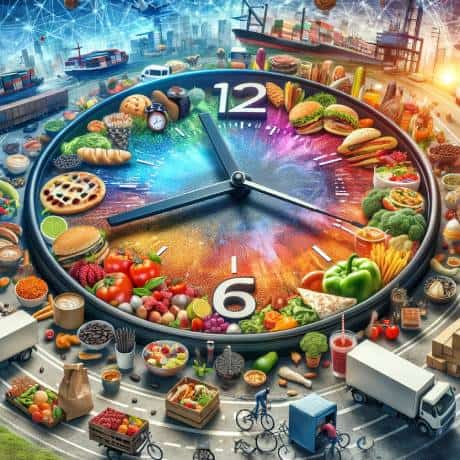
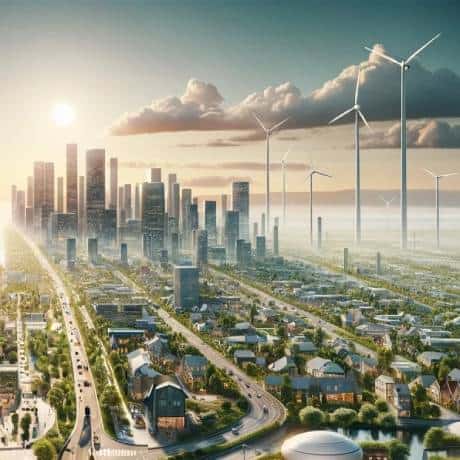












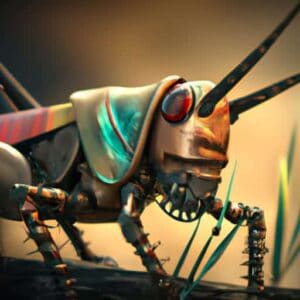 Eating insects may sound strange to some, but it is quite common. More than 2 billion people around the world regularly consume insects (2). This staggering statistic should not be surprising, considering there are an estimated 10 quintillion (that’s 10,000,000,000,000,000,000) individual insects alive at any given time.
Eating insects may sound strange to some, but it is quite common. More than 2 billion people around the world regularly consume insects (2). This staggering statistic should not be surprising, considering there are an estimated 10 quintillion (that’s 10,000,000,000,000,000,000) individual insects alive at any given time. ent, and enteric fermentation are estimated to use about one-third of the world’s fresh water.
ent, and enteric fermentation are estimated to use about one-third of the world’s fresh water.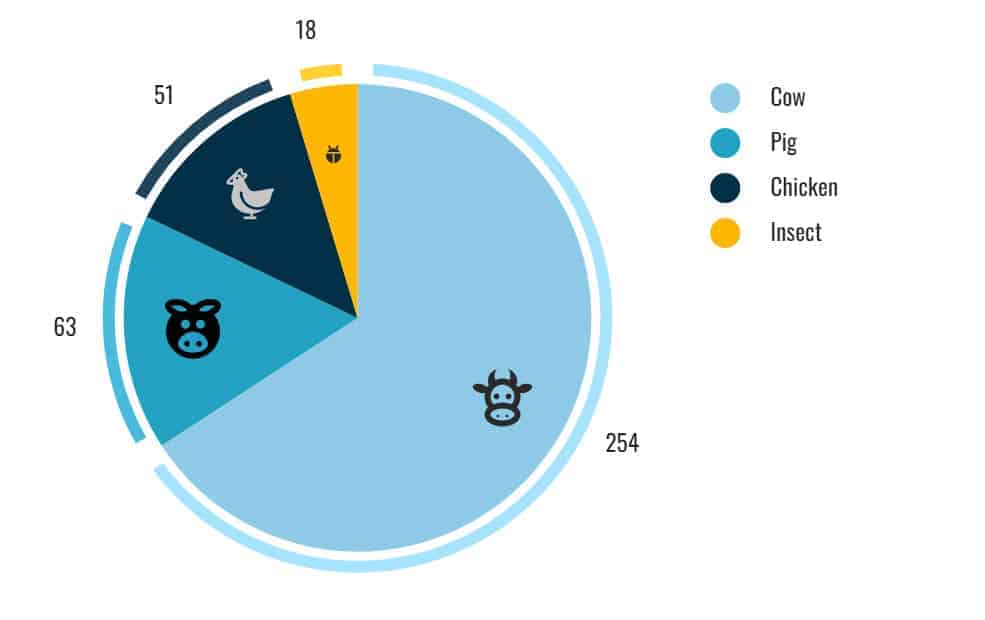 Farmland required per gram of protein in livestock vs. insect farming as of 2018, by species (in square meters) Source:
Farmland required per gram of protein in livestock vs. insect farming as of 2018, by species (in square meters) Source: 